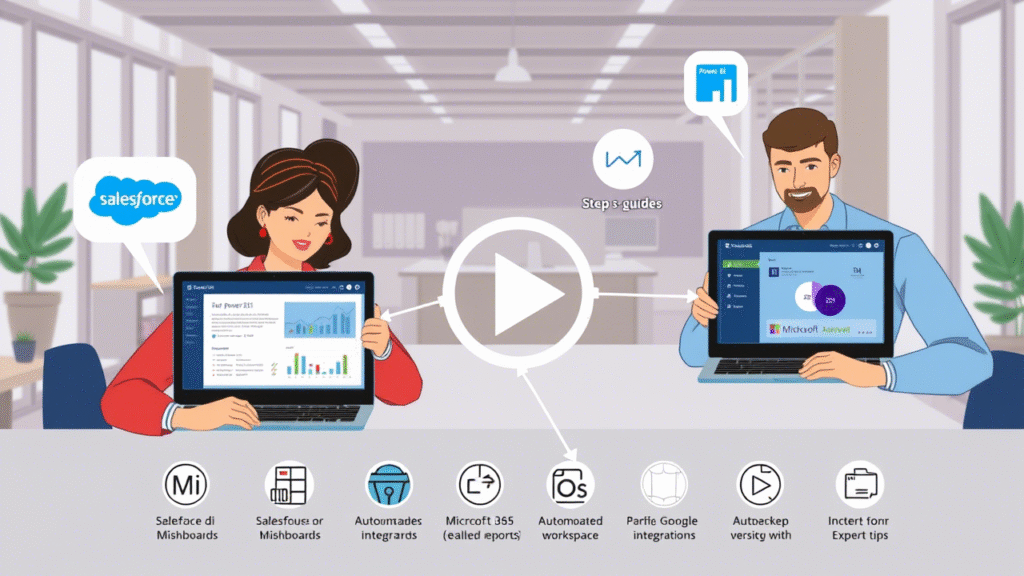Shopping Cart (1)
Subtotal: $5.00

In today’s data-driven world, businesses rely heavily on real-time insights to make informed decisions. However, the true power of analytics lies not just in individual tools but in how well they work together. Enter Power BI Pro , Microsoft’s collaborative analytics service that allows users to share reports, dashboards, and datasets across teams and departments.
While Power BI Pro offers robust visualization and reporting features out of the box, its full potential is realized when integrated with other platforms. By connecting Power BI Pro with third-party tools like Salesforce, Google Workspace, Microsoft 365, and Azure, organizations can streamline workflows, centralize reporting, and unlock deeper insights from disparate data sources.
In this comprehensive guide, you’ll learn:
Whether you’re a business analyst, IT administrator, or decision-maker, this guide will help you harness the full capabilities of Power BI Pro through strategic integrations.
Power BI Pro is a cloud-based analytics tool designed for professionals who need to share interactive reports and dashboards across an organization. Unlike Power BI Desktop , which is free and used for report creation, Power BI Pro enables users to publish, share, and collaborate on reports with others — even those without a Pro license.
Here’s how Power BI Pro compares to other editions:
| Feature | Power BI Desktop | Power BI Pro | Power BI Premium |
|---|---|---|---|
| Report Creation | ✅ | ✅ | ✅ |
| Publishing Reports | ❌ | ✅ | ✅ |
| Sharing Reports | ❌ | ✅ (with Pro Users) | ✅ (with Anyone) |
| Access to Datasets | Local Only | Cloud-Based | Dedicated Capacity |
| API Access | Limited | Full API Access | Full API Access |
Source: Microsoft Power BI Editions Comparison
Power BI Pro supports over 100 native data connectors , allowing seamless integration with databases, SaaS platforms, and cloud services. Additionally, it provides REST APIs for custom integrations, making it highly flexible for enterprise environments.
Integrating Power BI Pro with other tools delivers several key benefits:
According to Gartner, “Organizations that integrate their BI tools with operational systems see a 40% improvement in decision-making efficiency.” This underscores the importance of integrating Power BI Pro into your broader tech stack.
As part of the Microsoft ecosystem, Power BI Pro integrates natively with core productivity and cloud services such as Microsoft 365 , Azure , and Microsoft Teams . These integrations enhance collaboration, automate data flows, and provide secure access to business intelligence.
You can embed Power BI reports directly into SharePoint and OneDrive , making it easy for users to access dashboards alongside other business documents.
You can also share dashboards via Outlook emails or schedule automatic updates to be sent to stakeholders.
For enterprises leveraging Azure cloud services , Power BI Pro offers deep integration with:
Connecting to these services ensures high-performance data processing and secure access control.
A financial institution uses Azure SQL Database to store transactional data and connects it to Power BI Pro for real-time fraud detection dashboards.
Microsoft Teams has become the hub for workplace communication. With Power BI Pro, you can pin live dashboards to Teams channels and receive scheduled report updates within chats.
This integration keeps everyone aligned with the latest KPIs and metrics without leaving the Teams interface.
Tip: For visual learners, consider embedding a short video tutorial showing how to pin a dashboard in Teams.

Customer Relationship Management (CRM) and Enterprise Resource Planning (ERP) systems are often the backbone of business operations. Integrating Power BI Pro with these platforms enables real-time analytics that drive smarter sales, customer service, and supply chain decisions.
Power BI Pro supports direct connections to major platforms including:
Each system comes with specific connectors and authentication methods.
Salesforce stores vast amounts of customer and sales data. To connect it with Power BI Pro:
Alternatively, use CData or Import2 connectors for more advanced dataflows.
Dynamics 365 users benefit from a native connector in Power BI Pro:
SAP integration typically involves OData feeds or direct database connections:
| System | Business Value |
|---|---|
| Salesforce | Sales forecasting, pipeline analysis, customer segmentation |
| Dynamics 365 | Unified view of operations, inventory tracking, service analytics |
| SAP | Financial reporting, supply chain optimization, compliance monitoring |
A large retail chain integrated Salesforce with Power BI Pro to analyze regional sales trends. Using dashboards updated in real time, the company reduced forecasting errors by 30% and improved promotional campaign targeting.
Cloud storage platforms like Google Drive , Dropbox , and SharePoint play a critical role in file sharing and collaboration. Integrating Power BI Pro with these services ensures that your PBIX files and datasets remain accessible, version-controlled, and up-to-date.
With cloud integrations, Power BI Pro supports:
Report_v1.2.pbix)These practices ensure smooth teamwork and reduce the risk of data inconsistencies.

For developers and advanced users, Power BI Pro opens up powerful automation opportunities through its REST API and integration with Power Automate (formerly Flow) .
The Power BI REST API allows programmatic control over:
This API is ideal for automating repetitive tasks or building custom dashboards for clients.
powershell
1
2
3
4
5
6
# Sample script to trigger a dataset refresh
$authToken = Get-PowerBIAccessToken -ErrorAction Stop
$workspaceId = “your-workspace-id”
$datasetId = “your-dataset-id”
Invoke-PowerBIRestMethod -Url “groups/$workspaceId/datasets/$datasetId/refreshes” -Method Post -AuthToken $authToken
Note: You’ll need to install the Power BI Cmdlets module from the PowerShell Gallery.
Power Automate enables no-code automation of workflows involving Power BI Pro. For example:
For software vendors or enterprise developers, Power BI Embedded allows you to embed dashboards into custom applications or white-label products.
This feature is particularly useful for:
Security should never be an afterthought, especially when dealing with sensitive business data. Power BI Pro includes robust features to ensure compliance and governance across all integrations.
These certifications ensure that Power BI Pro meets global standards for data protection and privacy.
Power BI Pro supports Role-Based Access Control (RBAC) at both the workspace and dataset levels. Administrators can define roles such as:
Additionally, Row-Level Security (RLS) can be applied to restrict data visibility based on user roles. For instance, a sales manager might only see data for their region.
To track changes and ensure accountability, Power BI Pro offers:
“Governance starts with understanding your data flow. Define clear ownership of datasets, implement RLS early, and regularly review access logs,” says John Doe, Microsoft MVP and BI Architect .
By following best practices in governance, organizations can maintain compliance and reduce the risk of data breaches.

Even with proper setup, issues can arise during integration. Here are some common problems and how to resolve them.
| Issue | Solution |
|---|---|
| Authentication Failures | Double-check credentials; use managed identities where possible |
| Gateway Connection Issues | Ensure the on-premises data gateway is running and configured correctly |
| Data Refresh Timeouts | Optimize queries or increase timeout thresholds |
| Permission Denied Errors | Review RBAC settings and grant appropriate access rights |
| API Call Limits Exceeded | Throttle requests or upgrade to Power BI Premium for higher limits |
Proactively addressing integration issues ensures minimal downtime and consistent reporting accuracy.
Integrating Power BI Pro with other tools unlocks a world of possibilities for modern businesses. Whether you’re connecting to Microsoft 365 for better collaboration, syncing with Salesforce for enhanced sales analytics, or automating workflows via REST APIs, each integration brings you closer to a unified, data-driven organization.
By following best practices in configuration, governance, and troubleshooting, you can ensure that your Power BI Pro integrations deliver accurate, timely insights across your enterprise.
Start small, test each integration thoroughly, and gradually scale your analytics ecosystem. As you do, you’ll find that Power BI Pro becomes more than just a reporting tool — it becomes the foundation of your business intelligence strategy.
Yes, Power BI Pro supports over 100 data connectors, including Salesforce, Oracle, Google Analytics, and more.
Use Power BI Pro licenses to share reports with external users or publish apps to Power BI Premium for broader distribution.
No hard limit exists, but performance depends on data complexity and licensing tier.
Power BI Pro licenses cost $10/user/month. Additional costs may include premium gateways, API usage, or third-party connectors.
Free accounts allow 8 daily refreshes; Power BI Pro users get up to 48/day, depending on the source.
Ready to take your Power BI Pro integrations to the next level?
📥 Download our FREE Power BI Integration Roadmap Template — a step-by-step guide to planning, implementing, and managing your integrations effectively.
📧 Subscribe to our newsletter for expert tips, tutorials, and case studies delivered straight to your inbox.
🤝 Contact us today for customized consulting services tailored to your organization’s unique needs. Let our certified Power BI experts help you build a scalable, secure, and high-performing analytics environment.
Don’t let fragmented data hold you back — integrate Power BI Pro and unlock the full power of your business intelligence.
Let me know if you’d like this formatted as a downloadable PDF, or if you’d like accompanying infographics, screenshots, or social media snippets to promote the article!
keyswholsale©2024 . All Rights Reserved. Designed by keyswholsale.com
Select at least 2 products
to compare